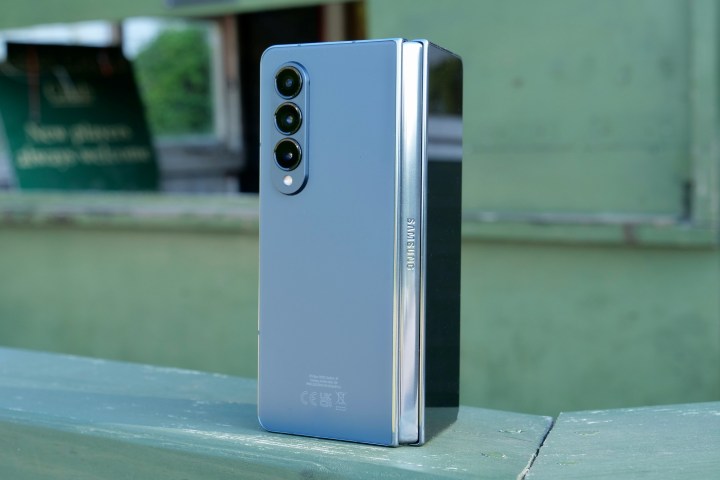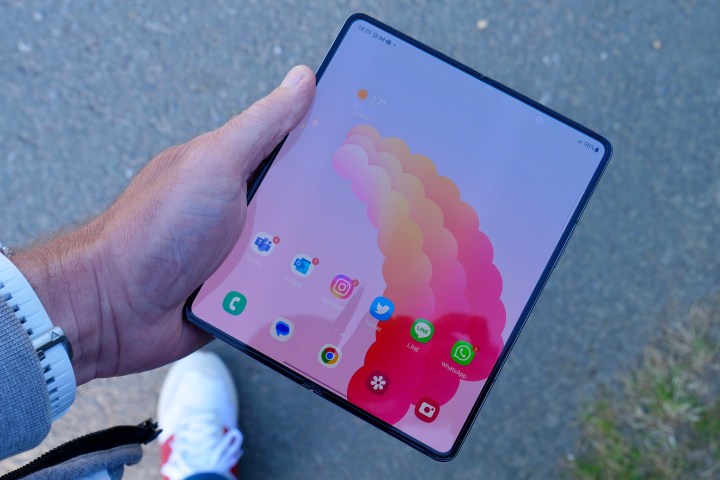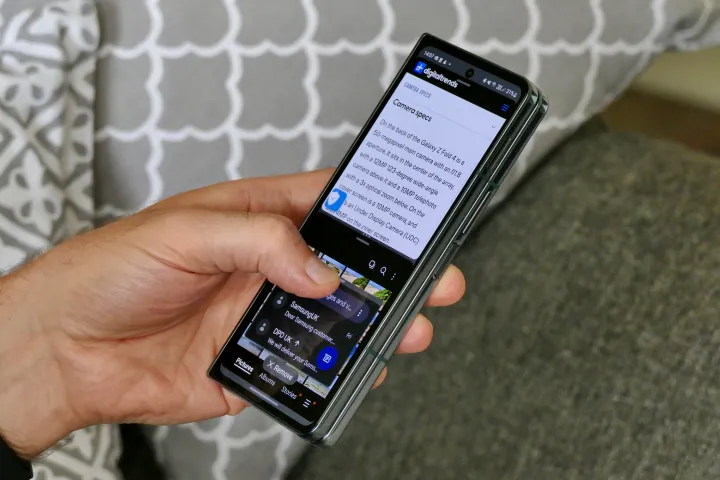Samsung is once again trying to woo foldable phone enthusiasts back into its camp with the new Samsung Galaxy Z Fold 6. The key attraction this time around is a fresh design served in a thinner chassis. There’s a faster chipset inside, a slightly more durable build, a redesigned hinge mechanism, and a shallower crease on the inner foldable panel.
All that comes at a $100 price increase, though. Needless to say, it doesn’t sound like a particularly exciting year-on-year upgrade compared to the Galaxy Z Fold 5 and it’s certainly not a standout device compared to rivals like the OnePlus Open and the Vivo X Fold 3 Pro.
But if you’ve been rocking the Galaxy Z Fold 4 and are of two minds as to whether to stay put or splurge on an upgrade, there are a few aspects you should keep in mind. In this comparison, we are going to focus on the key differences that should matter to buyers.
Samsung Galaxy Z Fold 6 vs. Galaxy Z Fold 4: specs
| Samsung Galaxy Z Fold 6 | Samsung Galaxy Z Fold 4 | |
| Size | 68.1 x 153.5 x 12.1mm (folded)
132.6 x 153.5 x 5.6mm (unfolded) |
67.1 x 155.1 x 15.8mm (Hinge) ~ 14.2mm (Sagging)
130.1 x 155.1 x 6.3mm (unfolded) |
| Weight | 239 grams | 263 grams |
| Colors | Silver Shadow
Pink Navy Crafted Black (online exclusive) Purity White (online exclusive) |
Graygreen
Phantom Black Beige Burgundy (online exclusive) |
| Price | Starts at $1,900 | Starts at $1,800 |
| Cover display | 6.3-inch HD+
Dynamic AMOLED 2X 2376 x 968 resolution with 22.1:9 aspect ratio at 410 ppi 120Hz refresh rate (1~120Hz) |
6.2-inch Dynamic AMOLED 2X
2316 x 904 resolution with 23.1:9 aspect ratio 120Hz refresh rate (48~120Hz) |
| Main display | 7.6-inch QXGA+
Dynamic AMOLED 2X Infinity Flex Display 2160 x 1856 resolution with 20.9:18 aspect ratio at 374 ppi 120Hz refresh rate 2,600 nits max brightness |
7.6-inch Foldable Dynamic AMOLED 2X
2176 x 1812 resolution with 21.6:18 aspect ratio at 373 ppi 120Hz refresh rate |
| Chipset | Qualcomm Snapdragon 8 Gen 3 for Galaxy | Qualcomm Snapdragon 8+ Gen 1 |
| RAM | 12GB | 12GB |
| Storage | 256GB
512GB 1TB |
256GB
512GB 1TB |
| Rear cameras | 50MP main with DPAF, OIS, f/1.8
10MP telephoto with DPAF, OIS, f/2.4, 3x optical zoom 12MP ultrawide with f/2.2, 123-degree FOV |
50MP main with DPAF, OIS, f/1.8
10MP telephoto with DPAF, OIS, f/2.4, 3x optical zoom 12MP ultrawide with f/2.2, 123-degree FOV |
| Selfie cameras | 10MP with f/2.2 (cover display)
4MP with f/1.8 (inner under-display camera) |
10MP with f/2.2 (cover display)
4MP with f/1.8 (inner under-display camera) |
| Battery | 4,400mAh | 4,400mAh |
| Charging | 25W fast charging
15W wireless charging 4.5W reverse wireless charging |
25W fast charging
15W wireless charging 4.5W reverse wireless charging |
| Water resistance | IP48 | IPX8 |
| Connectivity | 5G, LTE, Wi-Fi 6E, Bluetooth v5.3 | 5G, LTE, Wi-Fi 6E, Bluetooth v5.2 |
Galaxy Z Fold 6 vs. Galaxy Z Fold 4: design and build

For the Galaxy Z Fold 6, Samsung has created what it calls a “dual rail hinge structure” paired with a “strengthened folding edge” and a higher resilience to shock absorption alongside the frame. The company has also used an enhanced variety of Armor Aluminum and the second-gen Corning Gorilla Glass for the cover display and the rear shell.
Samsung won’t say what degree of added protection they offer, but these materials are certainly more resilient. The crease on the inner flexible screen is also smaller. The biggest difference, compared to the Galaxy Z Fold 4, is that there is no gap between the two halves of the phone when the phone is shut closed.
That’s a major relief, as the exposed gap allowed dust and liquid particles to make their way inside. Given the history of damages that many buyers have reported, the Galaxy Z Fold 6’s gapless design should be a key selling point. For the first time, Samsung has also added dust protection to its foldable, bestowing IP48 protection upon its latest phone.
The Galaxy Z Fold 4 only served an IPX8 level of water resistance, but no validated protection against dust. Better shock distribution to external impact might sound like typical marketing jargon, but in the context of a foldable, it’s anything but.

We recently investigated foldable hardware complaints at official Samsung centers and encountered issues where bumps and drops misaligned the hinge assembly. As a result, the Samsung foldable refused to open fully, and there were glue leakage issues. The Galaxy Z Fold 6 seems to have taken a much-needed measure to fix those woes.
Regarding the 2024 slate of foldable phones, Samsung says these make for “the most durable Galaxy Z series yet,” while also being the slimmest and lightest foldable phones it has ever made. In a nutshell, if your primary concern is the build quality, the Galaxy Z Fold 6 delivers practical benefits over the Galaxy Z Fold 4.
Galaxy Z Fold 6 vs. Galaxy Z Fold 4: internals

Samsung has armed the Galaxy Z Fold 6 with Qualcomm’s Snapdragon 8 Gen 3 chip, while the Galaxy Z Fold 4 relies on the Snapdragon 8+ Gen 1 silicon. There’s definitely a performance boost on the table, but both are based on the 4nm process, so the lift isn’t as huge as one would expect from phones spaced two years apart.
Both phones come with 12GB of RAM and memory options starting at 256GB and going all the way up to 1TB. The battery capacity also remains the same at 4,400 mAh, and so do the charging credentials, which max out at 25 watts for wired charging.
The Galaxy Z Fold 6 embraces the multi-eSIM format, but that varies depending on the market where you buy it. Another minor change happens in the wireless connectivity department. The latest from Samsung uses Bluetooth v5.3, while the Galaxy Z Fold 4 sticks with the Bluetooth v5.2 standard.

The resolution remains mostly the same on the display, but there are two key changes. The cover display on the Galaxy Z Fold 6 is bigger at 6.3 inches and more “normal” compared to the oddly tall 6.1-inch front panel on the Galaxy Z Fold 4.
The on-screen fluidity will also be uniform across both screens on the new phone. The cover and inner OLED panels on the Galaxy Z Fold 6 can vary between 1Hz and 120Hz, adaptively optimizing to the on-screen content. On the Galaxy Z Fold 4, the cover display’s refresh rate can only drop to as low as 48Hz, while the peak remains identical at 120Hz.
Galaxy Z Fold 6 vs. Galaxy Z Fold 4: cameras

If you’re looking for new camera hardware, well, there is barely any. The only notable change — at least on paper — is the 4-megapixel under-display camera, which sees its field of view go from 80 degrees on the Galaxy Z Fold 4 to 85 degrees on the Galaxy Z Fold 6.
The rest of the hardware is identical. You get a 50MP main camera, a 12MP sensor for ultrawide capture, and a 10MP telephoto snapper with 3x optical zoom range. The cover screen offers a centrally aligned 10MP selfie camera.
There are some minor differences in the feature set. On the Galaxy Z Fold 6, you get a feature called “optical quality zoom 2x,” which Samsung says is enabled using an Adaptive Pixel sensor. The Galaxy Z Fold 4 could only capture 8K video at 24 frames per second (fps), but the Galaxy Z Fold takes it to 30 fps.
Something curious has happened on the slow-motion side of things. The Galaxy Z Fold 4 could do 960 ultra-slo-mo at HD resolution, but that frame rate is not available on the Galaxy Z Fold 6. Instead, it gets two additional options: 120 fps at FHD and 120 fps at UHD.
Galaxy Z Fold 6 vs. Galaxy Z Fold 4: software

The Galaxy Z Fold 6 runs Android 14-based One UI 6.1.1 out of the box. The Galaxy Z Fold 4 recently started getting One UI 6.1 thanks to a software update. Now, the UI experience will be familiar, but there are two crucial differences: the years of updates left and the AI experience.
Let’s start with the AI experience. There was a lot of AI chatter at the Unpacked event, and barring hardware-level limitations, the experience will be uniform across both phones. Samsung’s dedicated Galaxy AI website mentions the Galaxy Z Fold 4 and its ability to run features such as Circle to Search, Note Assist, Live Translate, and generative AI-powered photo editing — among others.
And it seems some of the newer AI innovations announced for the Fold 6 will also make it to older foldables, but we’re not sure if the Galaxy Z Fold 4 is on the list. “We also plan to roll out the new Galaxy AI features we announced today to select Galaxy devices by the end of the year,” Samsung’s Annika Bizon said at Unpacked.
Of course, not all Galaxy AI features appearing on the Galaxy Z Fold 6 will make it to the Galaxy Z Fold 4, so keep that in mind.

Next, let’s check the software longevity situation. Samsung will push four years of OS updates on the Galaxy Z Fold 4 and security updates for five years.
On the Galaxy Z Fold 6, the company has promised seven generations of yearly Android updates and security patches. That’s one of the best assurances out there, and if you intend to keep a foldable phone for the long run, this software update commitment is a major step in the right direction. It’s a,so important to note that the Z Fold 4 is already two years through its promised updates.
Galaxy Z Fold 6 vs. Galaxy Z Fold 4: verdict

The question of upgrading to the Galaxy Z Fold 6 is relatively straightforward. If your Galaxy Z Fold 4 is giving you hardware hell (necessitating immediate and expensive repairs) or you want a foldable that will stay in your pocket for the next half a decade at the very least, you should head over to Samsung’s website and score the best trade-in deal.
Otherwise, beyond a sturdier build and a cleaner design, there isn’t much that the Galaxy Z Fold 6 offers that should give you the proverbial FOMO. The AI features might look all jazzy and fancy, but think about whether you will use them daily and in meaningful ways.
Otherwise, it’s just a bunch of gimmicks that should never sway a person to part with $1,900 — the Galaxy Z Fold 6’s starting price — or more. On a personal note, I’ve got a Galaxy Fold 4 in my drawer, and I find little merit to justify an upgrade, even though the Galaxy Z Fold 6 in silver looks more tempting than a cup of sweet Vietnamese coffee.
Services Marketplace – Listings, Bookings & Reviews